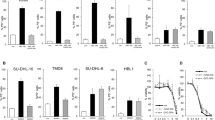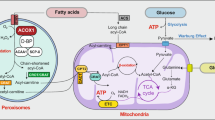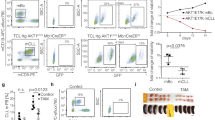Abstract
The peroxisome-proliferator-activated receptor (PPAR) γ agonist, CDDO, is under investigation for use in various malignancies. The mechanisms by which CDDO induces apoptosis are controversial. We have therefore sought to determine these mechanisms using primary chronic lymphocyte leukemic (CLL) cells and Jurkat cell lines with defined apoptotic abnormalities. In these cells, CDDO induced-apoptosis involved caspase-independent loss in mitochondrial membrane potential followed by caspase processing. The pattern of CDDO-induced caspase processing, defined by use of a caspase inhibitor, strongly suggested that caspase-9 was the apical caspase. Moreover, CDDO induced apoptosis in caspase-8 and FADD-deficient but not in Bcl-xL overexpressing Jurkat cells. In CLL cells, CDDO induced an early release of mitochondrial cytochrome c and Smac that preceded apoptosis. Thus, in both cell types, CDDO induced apoptosis primarily by the intrinsic pathway with caspase-9 as the apical caspase. This has important implications in the design of novel agents for the treatment of CLL and other malignancies.
This is a preview of subscription content, access via your institution
Access options
Subscribe to this journal
Receive 12 print issues and online access
$259.00 per year
only $21.58 per issue
Buy this article
- Purchase on Springer Link
- Instant access to full article PDF
Prices may be subject to local taxes which are calculated during checkout






Similar content being viewed by others
References
Bratton SB, MacFarlane M, Cain K, Cohen GM . Protein complexes activate distinct caspase cascades in death receptor and stress-induced apoptosis. Exp Cell Res 2000; 256: 27–33.
van Loo G, Saelens X, van Gurp M, MacFarlane M, Martin SJ, Vandenabeele P . The role of mitochondrial factors in apoptosis: a Russian roulette with more than one bullet. Cell Death Differ 2002; 9: 1031–1042.
Li P, Nijhawan D, Budihardjo I, Srinivasula SM, Ahmad M, Alnemri ES et al. Cytochrome c and dATP-dependent formation of Apaf-1/caspase-9 complex initiates an apoptotic protease cascade. Cell 1997; 91: 479–489.
Cain K, Brown DG, Langlais C, Cohen GM . Caspase activation involves the formation of the aposome, a large (approximately 700 kDa) caspase-activating complex. J Biol Chem 1999; 274: 22686–22692.
Bratton SB, Walker G, Srinivasula SM, Sun XM, Butterworth M, Alnemri ES et al. Recruitment, activation and retention of caspases-9 and -3 by Apaf-1 apoptosome and associated XIAP complexes. EMBO J 2001; 20: 998–1009.
Ashkenazi A, Dixit VM . Death receptors: signaling and modulation. Science 1998; 281: 1305–1308.
Kersten S, Desvergne B, Wahli W . Roles of PPARs in health and disease. Nature 2000; 405: 421–424.
Murphy GJ, Holder JC . PPAR-gamma agonists: therapeutic role in diabetes, inflammation and cancer. Trends Pharmacol Sci 2000; 21: 469–474.
Willson TM, Lambert MH, Kliewer SA . Peroxisome proliferator-activated receptor gamma and metabolic disease. Annu Rev Biochem 2001; 70: 341–367.
Suh N, Wang Y, Honda T, Gribble GW, Dmitrovsky E, Hickey WF et al. A novel synthetic oleanane triterpenoid, 2-cyano-3,12-dioxoolean-1,9-dien-28-oic acid, with potent differentiating, antiproliferative, and anti-inflammatory activity. Cancer Res 1999; 59: 336–341.
Ito Y, Pandey P, Place A, Sporn MB, Gribble GW, Honda T et al. The novel triterpenoid 2-cyano-3,12-dioxoolean-1,9-dien-28-oic acid induces apoptosis of human myeloid leukemia cells by a caspase-8-dependent mechanism. Cell Growth Differ 2000; 11: 261–267.
Ito Y, Pandey P, Sporn MB, Datta R, Kharbanda S, Kufe D . The novel triterpenoid CDDO induces apoptosis and differentiation of human osteosarcoma cells by a caspase-8 dependent mechanism. Mol Pharmacol 2001; 59: 1094–1099.
Pedersen IM, Kitada S, Schimmer A, Kim Y, Zapata JM, Charboneau L et al. The triterpenoid CDDO induces apoptosis in refractory CLL B cells. Blood 2002; 100: 2965–2972.
Kim KB, Lotan R, Yue P, Sporn MB, Suh N, Gribble GW et al. Identification of a novel synthetic triterpenoid, methyl-2-cyano-3,12-dioxooleana-1,9-dien-28-oate, that potently induces caspase-mediated apoptosis in human lung cancer cells. Mol Cancer Ther 2002; 1: 177–184.
Almond JB, Snowden RT, Hunter A, Dinsdale D, Cain K, Cohen GM . Proteasome inhibitor-induced apoptosis of B-chronic lymphocytic leukaemia cells involves cytochrome c release and caspase activation, accompanied by formation of an approximately 700 kDa Apaf-1 containing apoptosome complex. Leukemia 2001; 15: 1388–1397.
MacFarlane M, Harper N, Snowden RT, Dyer MJ, Barnett GA, Pringle JH et al. Mechanisms of resistance to TRAIL-induced apoptosis in primary B cell chronic lymphocytic leukaemia. Oncogene 2002; 21: 6809–6818.
Harper N, Hughes M, MacFarlane M, Cohen GM . Fas-associated death domain protein and caspase-8 are not recruited to the tumor necrosis factor receptor 1 signaling complex during tumor necrosis factor-induced apoptosis. J Biol Chem 2003; 278: 25534–25541.
Sun XM, Bratton SB, Butterworth M, MacFarlane M, Cohen GM . Bcl-2 and Bcl-xL inhibit CD95-mediated apoptosis by preventing mitochondrial release of Smac/DIABLO and subsequent inactivation of X-linked inhibitor-of-apoptosis protein. J Biol Chem 2002; 277: 11345–11351.
Sun XM, MacFarlane M, Zhuang J, Wolf BB, Green DR, Cohen GM . Distinct caspase cascades are initiated in receptor-mediated and chemical-induced apoptosis. J Biol Chem 1999; 274: 5053–5060.
Dewson G, Snowden RT, Almond JB, Dyer MJ, Cohen GM . Conformational change and mitochondrial translocation of Bax accompany proteasome inhibitor-induced apoptosis of chronic lymphocytic leukemic cells. Oncogene 2003; 22: 2643–2654.
Medema JP, Scaffidi C, Kischkel FC, Shevchenko A, Mann M, Krammer PH et al. FLICE is activated by association with the CD95 death-inducing signaling complex (DISC). EMBO J 1997; 16: 2794–2804.
Slee EA, Harte MT, Kluck RM, Wolf BB, Casiano CA, Newmeyer DD et al. Ordering the cytochrome c-initiated caspase cascade: hierarchical activation of caspases-2, -3, -6, -7, -8, and -10 in a caspase-9-dependent manner. J Cell Biol 1999; 144: 281–292.
Bratton SB, Lewis J, Butterworth M, Duckett CS, Cohen GM . XIAP inhibition of caspase-3 preserves its association with the Apaf-1 apoptosome and prevents CD95- and Bax-induced apoptosis. Cell Death Differ 2002; 9: 881–892.
Srinivasula SM, Ahmad M, Fernandes-Alnemri T, Alnemri ES . Autoactivation of procaspase-9 by Apaf-1-mediated oligomerization. Mol Cell 1998; 1: 949–957.
Suh N, Wang Y, Williams CR, Risingsong R, Gilmer T, Willson TM et al. A new ligand for the peroxisome proliferator-activated receptor-gamma (PPAR-gamma), GW7845, inhibits rat mammary carcinogenesis. Cancer Res 1999; 59: 5671–5673.
Fehlberg S, Trautwein S, Goke A, Goke R . Bisphenol A diglycidyl ether induces apoptosis in tumour cells independently of peroxisome proliferator-activated receptor-gamma, in caspase-dependent and -independent manners. Biochem J 2002; 362: 573–578.
Acknowledgements
We thank Dr J Blenis (Harvard Medical School, Boston, MA, USA) for supplying the FADD- and caspase-8-deficient cells. Dr Satoshi Inoue is partially supported by the Daiwa Anglo-Japanese Foundation.
Author information
Authors and Affiliations
Corresponding author
Rights and permissions
About this article
Cite this article
Inoue, S., Snowden, R., Dyer, M. et al. CDDO induces apoptosis via the intrinsic pathway in lymphoid cells. Leukemia 18, 948–952 (2004). https://doi.org/10.1038/sj.leu.2403328
Received:
Accepted:
Published:
Issue Date:
DOI: https://doi.org/10.1038/sj.leu.2403328
Keywords
This article is cited by
-
The synthetic oleanane triterpenoid CDDO-Me binds and inhibits pyruvate kinase M2
Pharmacological Reports (2020)
-
SZC017, a novel oleanolic acid derivative, induces apoptosis and autophagy in human breast cancer cells
Apoptosis (2015)
-
Phase I study of the synthetic triterpenoid, 2-cyano-3, 12-dioxoolean-1, 9-dien-28-oic acid (CDDO), in advanced solid tumors
Cancer Chemotherapy and Pharmacology (2012)
-
Triterpenoids and rexinoids as multifunctional agents for the prevention and treatment of cancer
Nature Reviews Cancer (2007)
-
Deguelin inhibits expression of IκBα protein and induces apoptosis of B-CLL cells in vitro
Leukemia (2007)



